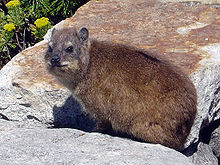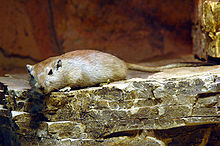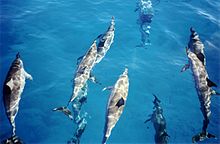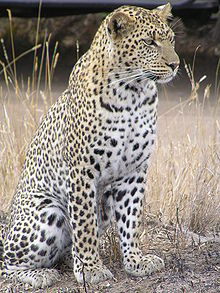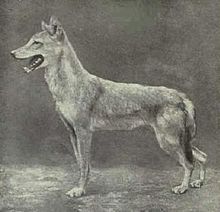- List of mammals of Egypt
-
This is a list of the mammal species recorded in Egypt. There are 100 mammal species in Egypt, of which 3 are critically endangered, 3 are endangered, 8 are vulnerable, and 1 is near-threatened. 3 of the species listed for Egypt are considered to be extinct.[1]
The following tags are used to highlight each species' conservation status as assessed by the IUCN:
EX Extinct No reasonable doubt that the last individual has died. EW Extinct in the wild Known only to survive in captivity or as a naturalized populations well outside its previous range. CR Critically Endangered The species is in imminent risk of extinction in the wild. EN Endangered The species is facing an extremely high risk of extinction in the wild. VU Vulnerable The species is facing a high risk of extinction in the wild. NT Near Threatened The species does not meet any of the criteria that would categorise it as risking extinction but it is likely to do so in the future. LC Least Concern There are no current identifiable risks to the species. DD Data Deficient There is inadequate information to make an assessment of the risks to this species. Some species were assessed using an earlier set of criteria. Species assessed using this system have the following instead of Near Threatened and Least Concern categories:
LR/cd Lower Risk/conservation dependent Species which were the focus of conservation programmes and may have moved into a higher risk category if that programme was discontinued. LR/nt Lower Risk/near threatened Species which are close to being classified as Vulnerable but are not the subject of conservation programmes. LR/lc Lower Risk/least concern Species for which there are no identifiable risks. Subclass: Theria
Infraclass: Eutheria
Order: Hyracoidea (hyraxes)
The hyraxes are any of four species of fairly small, thickset, herbivorous mammals in the order Hyracoidea. About the size of a domestic cat they are well-furred, with rounded bodies and a stumpy tail. They are native to Africa and the Middle East.
- Family: Procaviidae (hylaxes)
-
- Genus: Heterohyrax
- Yellow-spotted Rock Hyrax Heterohyrax brucei LC
- Genus: Procavia
- Cape Hyrax Procavia capensis LC
- Genus: Heterohyrax
-
Order: Sirenia (manatees and dugongs)
Sirenia is an order of fully aquatic, herbivorous mammals that inhabit rivers, estuaries, coastal marine waters, swamps, and marine wetlands. All four species are endangered.
- Family: Dugongidae
Order: Rodentia (rodents)
Rodents make up the largest order of mammals, with over 40 percent of mammalian species. They have two incisors in the upper and lower jaw which grow continually and must be keep short by gnawing. Most rodents are small though the capybara can weigh up to 45 kg (100 lb).
- Suborder: Hystricognathi
- Family: Hystricidae (Old World porcupines)
-
- Genus: Hystrix
- Crested Porcupine Hystrix cristata LC
- Genus: Hystrix
-
- Family: Hystricidae (Old World porcupines)
- Suborder: Sciurognathi
- Family: Gliridae (dormice)
- Subfamily: Leithiinae
- Genus: Eliomys
- Asian Garden Dormouse Eliomys melanurus LC
- Genus: Eliomys
- Subfamily: Leithiinae
- Family: Dipodidae (jerboas)
- Subfamily: Allactaginae
- Genus: Allactaga
- Four-toed jerboa Allactaga tetradactyla DD
- Genus: Allactaga
- Subfamily: Dipodinae
- Genus: Jaculus
- Lesser Egyptian Jerboa Jaculus jaculus LC
- Greater Egyptian Jerboa Jaculus orientalis LC
- Genus: Jaculus
- Subfamily: Allactaginae
- Family: Spalacidae
- Subfamily: Spalacinae
- Genus: Nannospalax
- Palestine Mole Rat Nannospalax ehrenbergi LC
- Genus: Nannospalax
- Subfamily: Spalacinae
- Family: Muridae (mice, rats, voles, gerbils, hamsters, etc.)
- Subfamily: Deomyinae
- Genus: Acomys
- Cairo Spiny Mouse Acomys cahirinus LC
- Golden Spiny Mouse Acomys russatus LR/lc
- Genus: Acomys
- Subfamily: Gerbillinae
- Genus: Dipodillus
- North African Gerbil Dipodillus campestris LC
- Mackilligin's Gerbil Dipodillus mackilligini LC
- Genus: Gerbillus
- Pleasant Gerbil Gerbillus amoenus DD
- Anderson's Gerbil Gerbillus andersoni LR/lc
- Flower's Gerbil Gerbillus floweri LC
- Gerbillus gerbillus LC
- Pygmy Gerbil Gerbillus henleyi LC
- Gerbillus nanus LC
- Pale Gerbil Gerbillus perpallidus LC
- Greater Egyptian Gerbil Gerbillus pyramidum LC
- Gerbillus simoni LC
- Genus: Meriones
- Sundevall's Jird Meriones crassus LC
- Libyan Jird Meriones libycus LC
- Shaw's Jird Meriones shawi LC
- Genus: Pachyuromys
- Fat-tailed Gerbil Pachyuromys duprasi LC
- Genus: Psammomys
- Sand Rat Psammomys obesus LC
- Genus: Sekeetamys
- Bushy-tailed Jird Sekeetamys calurus LC
- Genus: Dipodillus
- Subfamily: Murinae
- Genus: Arvicanthis
- African Grass Rat Arvicanthis niloticus LC
- Genus: Nesokia
- Short-tailed Bandicoot Rat Nesokia indica LC
- Genus: Arvicanthis
- Subfamily: Deomyinae
- Family: Gliridae (dormice)
Order: Lagomorpha (lagomorphs)
The lagomorphs comprise two families, Leporidae (hares and rabbits), and Ochotonidae (pikas). Though they can resemble rodents, and were classified as a superfamily in that order until the early 20th century, they have since been considered a separate order. They differ from rodents in a number of physical characteristics, such as having four incisors in the upper jaw rather than two.
Order: Erinaceomorpha (hedgehogs and gymnures)
The order Erinaceomorpha contains a single family, Erinaceidae, which comprise the hedgehogs and gymnures. The hedgehogs are easily recognised by their spines while gymnures look more like large rats.
- Family: Erinaceidae (hedgehogs)
- Subfamily: Erinaceinae
- Genus: Hemiechinus
- Desert Hedgehog Hemiechinus aethiopicus LR/lc
- Long-eared Hedgehog Hemiechinus auritus LR/lc
- North African Desert Hedgehog paraechinus aethiopicus
- Genus: Hemiechinus
- Subfamily: Erinaceinae
Order: Soricomorpha (shrews, moles, and solenodons)
The "shrew-forms" are insectivorous mammals. Shrews and solenodons closely resemble mice, while moles are stout-bodied burrowers.
- Family: Soricidae (shrews)
- Subfamily: Crocidurinae
- Genus: Crocidura
- Lesser White-toothed Shrew Crocidura suaveolens DD
- Flower's Shrew Crocidura floweri DD
- Olivier's Shrew Crocidura olivieri LC
- Egyptian Pygmy Shrew Crocidura religiosa DD
- Genus: Suncus
- House Shrew Suncus murinus DD
- Genus: Crocidura
- Subfamily: Crocidurinae
Order: Chiroptera (bats)
The bats' most distinguishing feature is that their forelimbs are developed as wings, making them the only mammals in the world naturally capable of flight. Bat species account for about 20% of all mammals.
- Family: Pteropodidae (flying foxes, Old World fruit bats)
- Subfamily: Pteropodinae
- Genus: Rousettus
- Egyptian fruit bat Rousettus aegyptiacus LC
- Genus: Rousettus
- Subfamily: Pteropodinae
- Family: Vespertilionidae
- Subfamily: Vespertilioninae
- Genus: Barbastella
- Eastern Barbastelle Barbastella leucomelas LR/lc
- Genus: Eptesicus
- Botta's Serotine Eptesicus bottae LC
- Genus: Hypsugo
- Desert Pipistrelle Hypsugo ariel DD
- Bodenheimer's Pipistrelle Hypsugo bodenheimeri LR/nt
- Genus: Nycticeinops
- Schlieffen's Twilight Bat Nycticeinops schlieffeni LC
- Genus: Otonycteris
- Desert Long-eared Bat Otonycteris hemprichii LR/lc
- Genus: Pipistrellus
- Egyptian Pipistrelle Pipistrellus deserti LC
- Kuhl's Pipistrelle Pipistrellus kuhlii LC
- Rüppel's Pipistrelle Pipistrellus rueppelli LC
- Genus: Plecotus
- Genus: Barbastella
- Subfamily: Vespertilioninae
- Family: Rhinopomatidae
- Genus: Rhinopoma
- Lesser Mouse-tailed Bat Rhinopoma hardwickei LC
- Greater Mouse-tailed Bat Rhinopoma microphyllum LC
- Genus: Rhinopoma
- Family: Molossidae
- Genus: Tadarida
- Egyptian Free-tailed Bat Tadarida aegyptiaca LC
- European Free-tailed Bat Tadarida teniotis LR/lc
- Genus: Tadarida
- Family: Emballonuridae
- Genus: Taphozous
- Naked-rumped Tomb Bat Taphozous nudiventris LC
- Egyptian Tomb Bat Taphozous perforatus LC
- Genus: Taphozous
- Family: Nycteridae
- Genus: Nycteris
- Egyptian Slit-Faced Bat Nycteris thebaica LC
- Genus: Nycteris
- Family: Rhinolophidae
- Subfamily: Rhinolophinae
- Genus: Rhinolophus
- Geoffroy's Horseshoe Bat Rhinolophus clivosus LC
- Lesser horseshoe bat Rhinolophus hipposideros LC
- Genus: Rhinolophus
- Subfamily: Hipposiderinae
- Genus: Asellia
- Trident Leaf-nosed Bat Asellia tridens LC
- Genus: Triaenops
- Persian Trident Bat Triaenops persicus LC
- Genus: Asellia
- Subfamily: Rhinolophinae
Order: Cetacea (whales)
The order Cetacea includes whales, dolphins and porpoises. They are the mammals most fully adapted to aquatic life with a spindle-shaped nearly hairless body, protected by a thick layer of blubber, and forelimbs and tail modified to provide propulsion underwater.
- Suborder: Odontoceti
- Superfamily: Platanistoidea
- Family: Delphinidae (marine dolphins)
- Genus: Steno
- Rough-toothed Dolphin Steno bredanensis DD
- Genus: Sousa
- Sousa chinensis DD
- Genus: Stenella
- Spinner Dolphin Stenella longirostris LR/cd
- Genus: Delphinus
- Common dolphin Delphinus delphis LR/lc
- Genus: Steno
- Family: Delphinidae (marine dolphins)
- Superfamily: Platanistoidea
Order: Carnivora (carnivorans)
There are over 260 species of carnivorans, the majority of which eat meat as their primary dietary item. They have a characteristic skull shape and dentition.
- Suborder: Feliformia
- Family: Felidae (cats)
- Family: Viverridae (civets, mongooses, etc.)
- Subfamily: Viverrinae
- Genus: Genetta
- Abyssinian Genet Genetta abyssinica DD
- Common Genet Genetta genetta LR/lc
- Genus: Genetta
- Subfamily: Viverrinae
- Family: Herpestidae (mongooses)
- Genus: Herpestes
- Egyptian Mongoose Herpestes ichneumon LR/lc
- Genus: Herpestes
- Family: Hyaenidae (hyaenas)
- Genus: Hyaena
- Striped Hyena Hyaena hyaena LR/nt
- Genus: Proteles
- Aardwolf Proteles cristatus LR/lc
- Genus: Hyaena
- Suborder: Caniformia
- Family: Canidae (dogs, foxes)
- Genus: Vulpes
- Rueppell's Fox Vulpes rueppelli DD
- Red Fox Vulpes vulpes LC
- Fennec Vulpes zerda VU
- Blanford's Fox Vulpes cana VU
- Genus: Canis
- Golden Jackal Canis aureus VU
- Genus: Vulpes
- Family: Mustelidae (mustelids)
- Genus: Mustela
- Least Weasel Mustela nivalis LR/lc
- Genus: Ictonyx
- Saharan Striped Polecat Ictonyx libyca LR/lc
- Striped Polecat Ictonyx striatus LR/lc
- Genus: Mellivora
- Ratel Mellivora capensis LR/lc
- Genus: Mustela
- Family: Canidae (dogs, foxes)
-
- Family: Phocidae (earless seals)
- Genus: Monachus
- Mediterranean Monk Seal Monachus monachus CR
- Genus: Monachus
- Family: Phocidae (earless seals)
Order: Perissodactyla (odd-toed ungulates)
The odd-toed ungulates are browsing and grazing mammals. They are usually large to very large, and have relatively simple stomachs and a large middle toe.
- Family: Equidae (horses etc.)
- Genus: Equus
- African Wild Ass Equus africanus CR
- Genus: Equus
Order: Artiodactyla (even-toed ungulates)
The even-toed ungulates are ungulates whose weight is borne about equally by the third and fourth toes, rather than mostly or entirely by the third as in perissodactyls. There are about 220 artiodactyl species, including many that are of great economic importance to humans.
- Family: Suidae (pigs)
- Family: Hippopotamidae (hippopotamuses)
- Genus: Hippopotamus
- Hippopotamus Hippopotamus amphibius EX
- Genus: Hippopotamus
- Family: Bovidae (cattle, antelope, sheep, goats)
- Subfamily: Alcelaphinae
- Genus: Alcelaphus
- Red Hartebeest Alcelaphus buselaphus LR/cd
- Genus: Alcelaphus
- Subfamily: Antilopinae
- Genus: Gazella
- Dorcas Gazelle Gazella dorcas VU
- Mountain Gazelle Gazella gazella VU
- Rhim Gazelle Gazella leptoceros EN
- Genus: Gazella
- Subfamily: Caprinae
- Genus: Ammotragus
- Barbary Sheep Ammotragus lervia VU
- Genus: Capra
- Nubian Ibex Capra nubiana EN
- Genus: Ammotragus
- Subfamily: Hippotraginae
- Genus: Addax
- Addax Addax nasomaculatus CR
- Genus: Oryx
- Scimitar Oryx Oryx dammah EX
- Arabian Oryx Oryx leucoryx EN
- Genus: Addax
- Subfamily: Alcelaphinae
Notes
- ^ This list is derived from the IUCN Red List which lists species of mammals and includes those mammals that have recently been classified as extinct (since 1500 AD). The taxonomy and naming of the individual species is based on those used in existing Wikipedia articles as of 21 May 2007 and supplemented by the common names and taxonomy from the IUCN, Smithsonian Institute, or University of Michigan where no Wikipedia article was available.
References
- "The IUCN Red List of Threatened Species: Mammals of Egypt". IUCN. 2001. http://www.iucnredlist.org/search/search.php?kingname=ANIMALIA&phyname=CHORDATA&claname=MAMMALIA&freetext=&modifier=phrase&criteria=wholedb&taxa_species=1&redlistCategory%5B0%5D=all&redlistAssessyear%5B0%5D=all&country%5B0%5D=EG&aquatic%5B0%5D=all®ions%5B0%5D=all&habitats%5B0%5D=all&threats%5B0%5D=all&Submit_x=34&Submit_y=9&extendedResults=0&terrestrial=0&marine=0&freshwater=0&offset=0&sortorder%5B0%5D=spcscientificname&sortorder%5B1%5D=genname&sortorder%5B2%5D=spcname&sortorder%5B3%5D=spcauthor&sortorder%5B4%5D=spcinfrarank&sortorder%5B5%5D=spcinfraepithet&sortorder%5B6%5D=spcinfrarankauthor&sortorder%5B7%5D=spcstockname&sortorder%5B8%5D=comname_comp&sortorder%5B9%5D=rlcabb&sortorder%5B10%5D=rlscriteria&sortorder%5B11%5D=poptrend_code&sortorder%5B12%5D=rlcatcrit2001&sortorder%5B13%5D=spcrecid&sortorder%5B14%5D=kingname&debug=0&taxa_subspc=0&taxa_stock=0&newsort=Genus. Retrieved 22 May 2007.[dead link]
- "Mammal Species of the World". Smithsonian National Museum of Natural History. 2005. Archived from the original on 27 April 2007. http://web.archive.org/web/20070427043030/http://nmnhgoph.si.edu/msw/. Retrieved 22 May 2007.
- "Animal Diversity Web". University of Michigan Museum of Zoology. 1995-2006. http://animaldiversity.ummz.umich.edu/site/index.html. Retrieved 22 May 2007.
See also
- List of chordate orders
- List of regional mammals lists
- List of prehistoric mammals
- Mammal classification
- New mammal species
List of mammals of Africa Sovereign
states- Algeria
- Angola
- Benin
- Botswana
- Burkina Faso
- Burundi
- Cameroon
- Cape Verde
- Central African Republic
- Chad
- Comoros
- Democratic Republic of the Congo
- Republic of the Congo
- Côte d'Ivoire (Ivory Coast)
- Djibouti
- Egypt
- Equatorial Guinea
- Eritrea
- Ethiopia
- Gabon
- The Gambia
- Ghana
- Guinea
- Guinea-Bissau
- Kenya
- Lesotho
- Liberia
- Libya
- Madagascar
- Malawi
- Mali
- Mauritania
- Mauritius
- Morocco
- Mozambique
- Namibia
- Niger
- Nigeria
- Rwanda
- São Tomé and Príncipe
- Senegal
- Seychelles
- Sierra Leone
- Somalia
- South Africa
- South Sudan
- Sudan
- Swaziland
- Tanzania
- Togo
- Tunisia
- Uganda
- Zambia
- Zimbabwe
States with limited
recognition- Sahrawi Arab Democratic Republic
- Somaliland
Dependencies and
other territories- Canary Islands / Ceuta / Melilla / Plazas de soberanía (Spain)
- Madeira (Portugal)
- Mayotte / Réunion (France)
- Saint Helena / Ascension Island / Tristan da Cunha (United Kingdom)
- Western Sahara
List of mammals of Asia Sovereign
states- Afghanistan
- Armenia
- Azerbaijan
- Bahrain
- Bangladesh
- Bhutan
- Brunei
- Burma (Myanmar)
- Cambodia
- People's Republic of China
- Cyprus
- East Timor (Timor-Leste)
- Egypt
- Georgia
- India
- Indonesia
- Iran
- Iraq
- Israel
- Japan
- Jordan
- Kazakhstan
- North Korea
- South Korea
- Kuwait
- Kyrgyzstan
- Laos
- Lebanon
- Malaysia
- Maldives
- Mongolia
- Nepal
- Oman
- Pakistan
- Philippines
- Qatar
- Russia
- Saudi Arabia
- Singapore
- Sri Lanka
- Syria
- Tajikistan
- Thailand
- Turkey
- Turkmenistan
- United Arab Emirates
- Uzbekistan
- Vietnam
- Yemen
States with limited
recognition- Abkhazia
- Nagorno-Karabakh
- Northern Cyprus
- Palestine
- Republic of China (Taiwan)
- South Ossetia
Dependencies and
other territories- Christmas Island
- Cocos (Keeling) Islands
- Hong Kong
- Macau
Categories:- Lists of mammals by location
- Egypt-related lists
- Family: Procaviidae (hylaxes)
Wikimedia Foundation. 2010.

